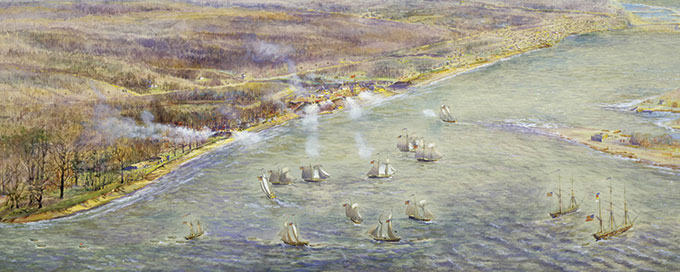Next story: Sue Gillick on Running for School Board
The Taking of Toronto
by Mason Winfield

The Maple Leaf nation rightly savors its defense of itself in the War of 1812. It may not like to be reminded that a US land-naval force made a week-long bitch out of Toronto.
On April 27, 1813, Major General Roger Hale Sheaffe (1763-1851) sat at his desk in York (today’s Toronto). Like many Canadians, the lieutenant governor of Upper Canada had been born elsewhere. A Bostonian Loyalist, the son of a Harvard grad, Sheaffe had joined the British army under the patronage of a lord. Remembered today as “the unsung Hero of Queenston Heights,” Sheaffe was not in his day unsung. In fact, he may have been overpromoted. Mutinies and unrest had plagued his commands during his career. All he did at Queenston was fail to mess up the edges in manpower, supply, and position he’d inherited after Isaac Brock fell. (Surrounded by half of Ontario, those 600 Americans had been stuck on that hill so long that you’d swear Nickleelan-Turner Overdrive was leading the cheering.) Sheaffe may be forgiven his consternation, though, to find somebody in the lake shellacking him with cannonfire. There was a lot of water between him and the US, and American Commodore Isaac Chauncey (1779-1840) had a reputation for caution.
The tippy-toe two-step between Chauncey and his British counterpart, Sir James Lucas Yeo (1782-1818)—each avoiding the other until he had guaranteed superiority—frustrated both sides in this war. (“Heroes of defeat,” US General Winfield Scott called them.) But Chauncey had worked all winter to build the US navy on Lake Ontario. It was the knight’s turn to be buffaloed, and Chauncey had arrived unopposed.
The plum lakeside target was Kingston, the Empire’s main Ontario base, but that was thought defended by 8,000 Redcoats. Attacking Kingston would have taken a greater force than the US had on this lake. Chipping away around it seemed a good first step. The Americans had come to the provincial capital of Upper Canada.
The town so wet that it was called “Muddy Little York” had been Ontario’s capital since 1797. (The first one was Newark, today’s Niagara-on-the-Lake.) York was top-heavy with government, and people who wanted to make it in this era made for it. Its core nestled into the curl of a cape. Unassailable by water from the east, its land defenses included cannon and a barracks of up to 800 Redcoats. Its landings on the west were protected by cannon batteries and a mini-fort called a blockhouse.
When Sheaffe found himself under assault from the bay, he presumed that this was a diversion, and that the American land force was already advancing from the west. He was right. He sent a couple hundred of his quick troops, Native Americans and Canadian militia, to head off the rush. However, in football terms, both forces were skill players; asking them to block O-linemen was a misuse of their talents. They lost 150 men quickly and melted away. The 1200 or so Americans advanced on the town with very few losses.
Sheaffe saw that the day was lost and took his Redcoats on the road to Kingston so fast that a trailing caravan of his personal possessions was captured, including his musical snuff-box. Sheaffe took a lot of heat for leaving the citizens and militia of York to their fates without fighting, but militarily, it was the correct move. One of the oldest adages of war is never to throw fresh troops into spoiled battles. Those Redcoats were major currency in the Northeast.
The York affair has more controversy. Once a side sends up the white flag, it’s supposed to freeze all war operations. The British-Canadians, however, were still scuttling war supplies as the Americans approached without caution, and and ammo dump blew up and launched massive rocks all over them. Hundreds of Americans were wounded and dozens killed, including charismatic young Brigadier General Zebulon Pike (1779-1813), author, explorer, and rising star in the American military. This might have been just a timing mixup, but to the outraged Americans it looked like they had been invited to walk right into a more efficient WMD than the age could otherwise develop. They, in turn, dilly-dallied the surrender ceremony, leaving time for a little more burning and pillaging. They stayed for a whole week.
The Battle of York has been called “a Pyrrhic victory,” costly enough to remind us of Greek King Pyrrhus’ line after a score over the Romans (loosely translated, “One more win like that and I’m toast”). But the U.S. captured cannon and ammunition at York that were destined for the British squadron on Lake Erie; they ended up being used against it, contributing to Oliver Perry’s September victory that blew the Empire’s whole game plan in the west. 1813 was off to a good start for the Yanks, and Chauncey’s navy was heading to the Niagara.
Mason Winfield is the author of 10 books, including Ghosts of 1812 (Western New York Wares, 2009), a history of the 1812 war on the Niagara.
blog comments powered by Disqus|
Issue Navigation> Issue Index > v12n17 (Week of Thursday, April 25) > The Taking of Toronto This Week's Issue • Artvoice Daily • Artvoice TV • Events Calendar • Classifieds |









 Current Issue
Current Issue